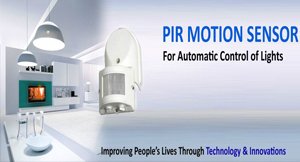91-11-45680580 & 9811138340.
General Information
Occupancy sensors detect the presence or absence of people and turn lights on and off accordingly. They may reduce lighting energy consumption by 50 percent or more in some circumstances, but the savings for any given installed sensor can be much less. As a result, it's important to carefully consider a wide variety of issues before installing an occupancy sensor in any specific location.
They are used most effectively in spaces that are often unoccupied, including some offices, warehouses, storerooms, restrooms, loading docks, corridors, stairwells, office lounges, and conference rooms. Open-plan office spaces, where one or more people may be moving in and out throughout the course of the workday, are not good candidates for occupancy sensors.
What Are the Options?
The two most common sensor types are passive infrared, which require a direct line of sight to the movement of infrared (heat) sources, and ultrasonic, which detect any movement, human or otherwise (for example, curtains).
Passive infrared (PIR) PIR sensors, the most commonly used type, are able to "see" heat emitted by occupants. Triggering occurs when a change in infrared levels is detected, as when a warm object moves in or out of view of one of the sensor's "eyes." PIR sensors are quite resistant to false triggering. They are best used within a 15-foot range for two reasons: first, there are potential "dead" spots between their wedge-shaped sensory patterns that get wider with distance (Figure 1); and, second, being passive, they do not send out any signal. Instead, PIR sensors depend on the intensity of the heat output of the moving part of the subject.
Figure 1: Sensor coverage diagram

Ultrasonic sensors can detect motion at any point within the contour lines. Infrared sensors see only in the wedge-shaped zones, and they don't generally see as far as ultrasonic units. The ranges are representative; actual sensors may be more or less sensitive.
Ultrasonic (US) Ultrasonic sensors emit a high-frequency (more than 20,000 cycles per second) sound above human and animal audibility ranges and listen for a change in frequency of the reflected sound. Because they emit a signal instead of receiving it, they are able to cover larger areas than PIR sensors and are more sensitive. US sensors are prone to false triggering and can be set off by air movement, such as that produced by a person running by a door or the on-off cycling of an HVAC system.
Microwave and audible sound sensors are less common. Audible sound sensors, which listen for noise made by people or machines, are best applied in an industrial facility or warehouse. Microwave sensors are similar to ultrasonics, in that they emit a signal and measure a change in frequency when that signal is reflected. However, they are seldom used, and little is known about their effectiveness.
Hybrid or dual-technology sensors incorporate features of both PIR and US sensors—or of other sensor types, such as microwave—in one sensor. The most common combination of sensor types is that of PIR and ultrasonic sensors, to take advantage of the PIR units' resistance to false triggering and the sensitivity of ultrasonics.
How to Make the Best Choice?
Measure cost savings A large East Coast U.S. utility found that occupancy sensors installed under its rebate program yielded average reductions in energy and demand of about 30 percent. Any given installation can range widely from this average, however. Table 1 illustrates the typical range of savings in various types of spaces.
Table 1: Typical range of savings from occupancy sensors
Savings range by a factor of two or three in most applications, with the exception of open-plan offices. Actual savings may differ.
Type of room |
Energy savings (%) |
Private office |
15 to 52 |
Open-plan office |
22 to 30 |
Classroom |
41 to 48 |
Conference room |
20 to 70 |
Restroom |
30 to 90 |
Corridors |
40 to 85 |
Storage area/closet |
45 to 80 |
To determine more precisely how effective occupancy sensors are likely to be, monitor patterns of lighting use and occupancy simultaneously. Several tools are available to do this:
• Lighting loggers. These count lighting hours, record the time-of-use or duration, and may even correlate duration with sensed occupancy. Recording ammeters may be connected at lighting breaker panels to determine when banks of rooms on a common electric feeder are using their lights. Savings can be determined by comparing the ammeter's data to work and cleaning schedules.
• Random surveys. Observing a building at night may reveal rooms where lights have been inadvertently left on, as may routine questioning of custodial and security personnel.
Evaluate cost-effectiveness Reducing energy consumption does not necessarily equal reduction in cost. A promotional video from one sensor manufacturer states that the installation of occupancy sensors on a 10-kilowatt lighting circuit in a major Gurgaon City building reduced lighting energy consumption by 56 percent. However, because the reduction in peak lighting demand was only 20 percent, the total savings—taking into account the cost of power at the time of savings and the actual demand charges involved—-were about 38 percent (see Figure 2).
Figure 2: Savings from a sensor installation in Gurgaon City, India

When demand changes are a significant portion of the total electrical bill—as in this case—the total savings from sensor installation may be considerately less than the energy savings if much of the energy savings occur during off-peak periods, when energy rates are lower and demand charges are not incurred.
Determine what kind of sensor you need. Ultrasonic sensors can detect small motions but are often triggered falsely. They are best used when a large area needs to be covered.
Passive infrared sensors are quite resistant to such false triggering, but are best used within a 15-foot range, since the "dead" spots in their sensory patterns become larger with distance. They are best used in smaller spaces.
Audible sensors are best applied in an industrial facility or warehouse, where machinery noise, rather than people, breaks the silence.
Choose either a wall or a ceiling mount. Wall-mounted sensors are suitable in smaller rooms—offices, bathrooms, and rooms that contain equipment (copiers, for example) but not people. In an open-plan office or wherever the lighting load is higher, mount the sensor in the ceiling. You can also find units that can be mounted in the corner or on the wall near the ceiling.
Ensure compatibility with other systems. Using occupancy sensors outside of their wattage ratings can damage or disable sensors, so make sure that the room or circuit wattage is sufficient. Many sensors are challenged by the larger surge demanded by electronic ballasts. Some models of sensors will suffer shortened lives when controlling their rated wattage of electronic ballasts.
Install sensors carefully. They are easily visible and can potentially be improperly adjusted, stolen, vandalized, or fooled into perceiving a human presence when a space is unoccupied. For continued energy savings, users should take precautions in positioning the sensors and train workers in the building about their purpose. The following steps have proven effective for sensors in general:
• Involve building personnel in planning for the sensors.
• Train maintenance personnel and office occupants to keep sensors operational, rather than disconnecting them as problems occur.
• Position sensors carefully so that they only "see" the area intended to be observed—the most common cause of false triggering of sensors is incorrect positioning.
• Alternatives to occupancy sensors Sometimes, when occupancy sensors are not cost-effective, there are better options for turning off lights.
• Custodial or security personnel can be required to switch off lights when they are not in use.
• Wiring into an existing energy management system may be cheaper than installing an occupancy sensor if lighting circuits are easily accessed and large areas can be turned off at one time.
• Individual areas can be controlled by timers that provide a defined "on" period.

Hamilton Electronics Pvt. Ltd. , is an ISO 9001 : 2000 Certified Company , engaged in the manufacturing of Switches & Sensors for Security Alarm Systems , Magnetic Door Contacts, Magnetic Security Switches and host of other Sensors.

PIR Sensors passive infrared detector that will give you the edges over the competition and secure your business contract in today's price oriented market. The company has a consistent record of growth and expansion with fast increasing sales turnover since its inception.

Float Sensor is an electrical ON/OFF Switch, which operates automatically when liquid level goes up or down with respect to specified level. The Signal thus available from the Float Sensor can be utilized for control of a Motor Pump or an allied electrical element like Solenoid, Lamps.